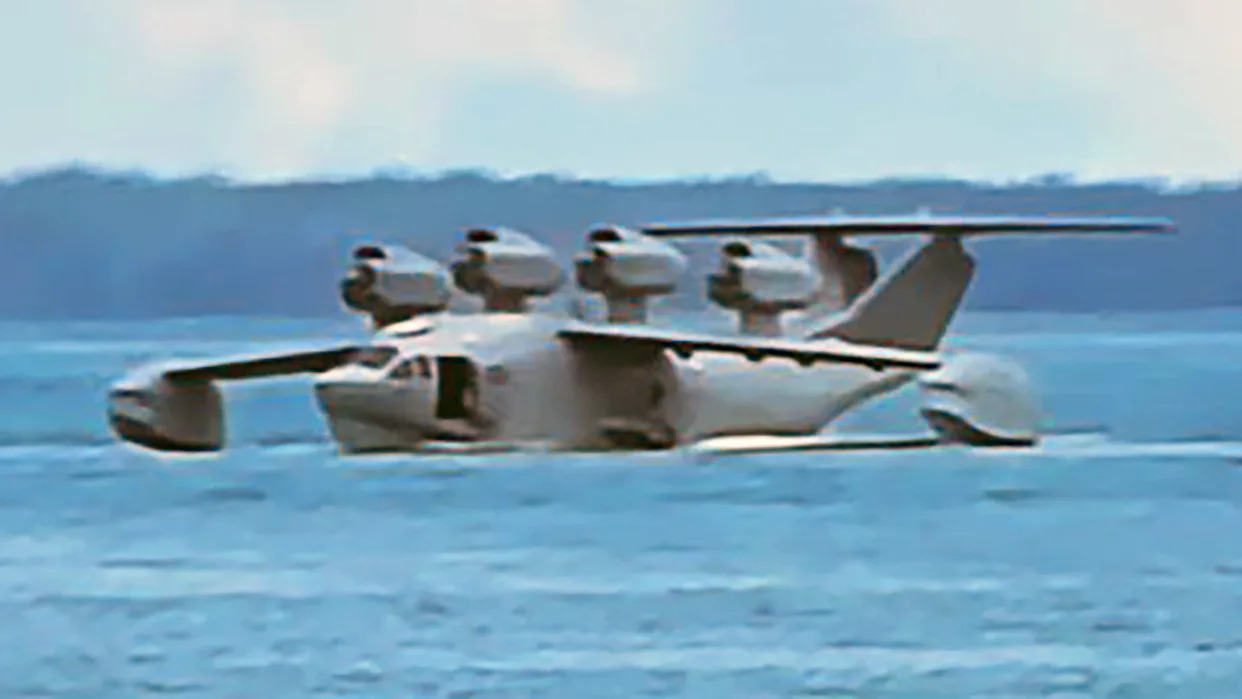We are getting our first full look at China’s wing-in-ground effect (WIG) craft. It was first identified last week by our friend and submarine warfare analyst HI Sutton. You can read his initial post at Naval News here. It was originally spotted in an image with its nose section obscured. In that image, the flying-boat-hulled aircraft was pictured sitting on a pier situated on the Bohai Sea, which sits at the northwestern reach of the South China Sea.

As we have discussed many times before, the Soviet Union was famed for its experimentation and semi-operational use of large WIG craft known as Ekranoplans. The capability and tactical concepts surrounding it never really caught on en-masse, but we are currently experiencing a renaissance of sorts for large WIG aircraft that aim to race above the thick air above the water with relative efficiency and speed (most can fly less efficiently at higher altitudes too). The U.S. is developing just such an aircraft, the Liberty Lifer, in hopes that it could be used to deliver heavy cargo, personnel and materiel to far-flung locales across the great expanses of the Pacific. In doing so it would help reduce some of the Pentagon’s looming logistic woes were it to fight across such a large theater.
In the case of this mysterious aircraft being tested by China, it is loosely similar in scale to what we have seen of their new amphibious flying boat, the AG600, which is intended to perform resupply, search and rescue, and other missions, especially over the South China Sea. This WIG aircraft appears ideally suited for similar applications in the littorals.

Flying low utilizing the thick cushion of air above the water to increase lift and decrease drag, the aircraft also stays under the surface/land-based radar horizon. Considering it is an aircraft, not a boat, it isn’t vulnerable to mines, submarines, and other dangers that can lurk even in seemingly lower-threat waters. Still, it is not a survivable asset in a highly contested combat arena, but if a war were to erupt between the U.S. and China, China would be fighting in their own backyard, unlike the United States. Vast areas extending from its shores will remain readily accessible for periods of time. This is where such an aircraft would be useful even in a high-end fight — providing logistical support to remote areas and especially in recovering downed aircrew and other personnel. Even sea control and anti-submarine warfare applications are real possibilities.
The biggest claim surrounding this aircraft is that it’s jet powered. The image of its rear seems to point to that, but at the time we thought this remained very inconclusive as it looked like propellers may have been intended for it but not yet fitted. Still the exhausts looked large for a turboprop. This new pictures from the front is also inconclusive and there may be spindles or at least some sort of spike at the front of the engine nacelles, which would point to propellers. There are also upper inlets as well, which would mean two large inlets per nacelle if it was jet powered, which seems odd. It’s also quite possible that this uses a new hybrid-electric propulsion system, which may make a lot of sense for this kind of aircraft. Regardless, these are low-resolution images that are sparse in details, and the aircraft could end up being jet powered, but it remains a significant question mark for us.
As for the rest of the aircraft, it has a large joined v-tail, which is not uncommon for WIG craft. The wings have large outrigger wing-float sponsons on their tips and the hull appears to have smaller sponsons amidships. The nose is perhaps the most exotic element and it looks blended for efficiency, at least in a modern sense. The aircraft very likely leverages heavy use of composite structures allowing for weight savings, aerodynamic enhancement, and limited signature control as a byproduct. We also see a common flying boat stepped hull and a larger door open on its side, which would be useful for hauling cargo and recovering personnel.
It’s also worth noting that this aircraft could very well be a technology demonstrator that is meant to test a variety of design elements. It could even be a subscale one, or it could be meant to at least inform larger designs. On that note, it has clear similarities to the Pentagon’s Liberty Lifter very large WIG craft that is in the works.

So there you have it, our first full view of the “Bohai Sea Monster,” as Sutton calls it. As with any new aircraft ‘leaks’ out of China, we should see a steady stream of higher-resolution imagery of this craft in the weeks to come.
Contact the author: Tyler@twz.com
Yahoo News – Latest News & Headlines
Read the full article .


